A couple of days ago, Elon Musk launched the latest in the series of Tesla vehicles.
We already have:
Model S – Premium 4-door sedan
Model 3 (Should be E, but Ford wouldn’t let Tesla use that)
Model X – Premium SUV
Model Y is the newest incantation – 7 Seater.
So is Tesla as SEXY as Elon would have the world believe? With the advent of price sensible cars, the mass market rather than the affluent finally get access to an electric vehicle.
Tesla Model 3 base model is around $35,000 in the USA, but that will probably translate to around $55,000 Aussie dollars.
In 2020, the Model Y will launch priced from $US39,000 but that priced model will probably be available in 2021. In the meantime, the AWD, Performance and Long Range will ensure that Tesla profits from the model.
Here’s the press release from Tesla and the launch video from YouTube. It’s a bit of a long read, but if you’re interested in EV’s – all types of EV’s – you’ll enjoy.
Model Y is an all-electric, mid-size SUV designed for maximum versatility and safety. Model Y will start at $39,000 for the Standard Range version, and will also come in Long Range, Dual-Motor All-Wheel Drive, and Performance variants.
Model Y is spacious enough to carry seven adults and their gear and offers leading range, superior performance, and the most advanced technology. The high-efficiency powertrain and ultra-responsive motors will provide 0-60 mph acceleration in as little as 3.5 seconds and a top speed of up to 150 mph, with excellent handling for any road condition. Model Y Standard Battery will have 230 miles of range, while Model Y Long Range will be able to travel up to 300 miles on a single charge.
Inside, Model Y’s panoramic glass roof and high seating creates a feeling of spaciousness and offers an expansive view from every seat in the vehicle. The front trunk and split-folding second-row seats provide a total of 66 cubic feet (1.9 cubic meters) of storage space. Like Model 3, Model Y requires no keys, but instead connects to your smartphone for seamless entry and exit, with a single 15-inch touchscreen interface inside for all of the car’s controls. Model Y also connects with the Tesla Mobile app for unique, easy-to-access features like remote unlock, Summon, remote pre-conditioning, location tracking, Speed Limit Mode, and much more.
Model Y is designed to be the safest mid-size SUV. Built from the ground up as an electric vehicle, the low center of gravity, rigid body structure and large crumple zones provide unparalleled protection. Its aerodynamic design and leading battery technology also make it highly-efficient in terms of energy usage, meaning you can achieve better range with less energy than other EVs on the market. Model Y is also compatible with our current Supercharger network of more than 12,000 Superchargers in 36 countries, as well as our new V3 Superchargers which can charge at rates up to 1,000 miles per hour.
Deliveries are expected to begin in Fall 2020 for Model Y Performance, Long Range Rear-Wheel Drive, and Dual-Motor All-Wheel Drive variants, and early 2021 for the $39,000 Model Y Standard Range. Please visit our Design Studio to see available options and current delivery estimates.
Roadster
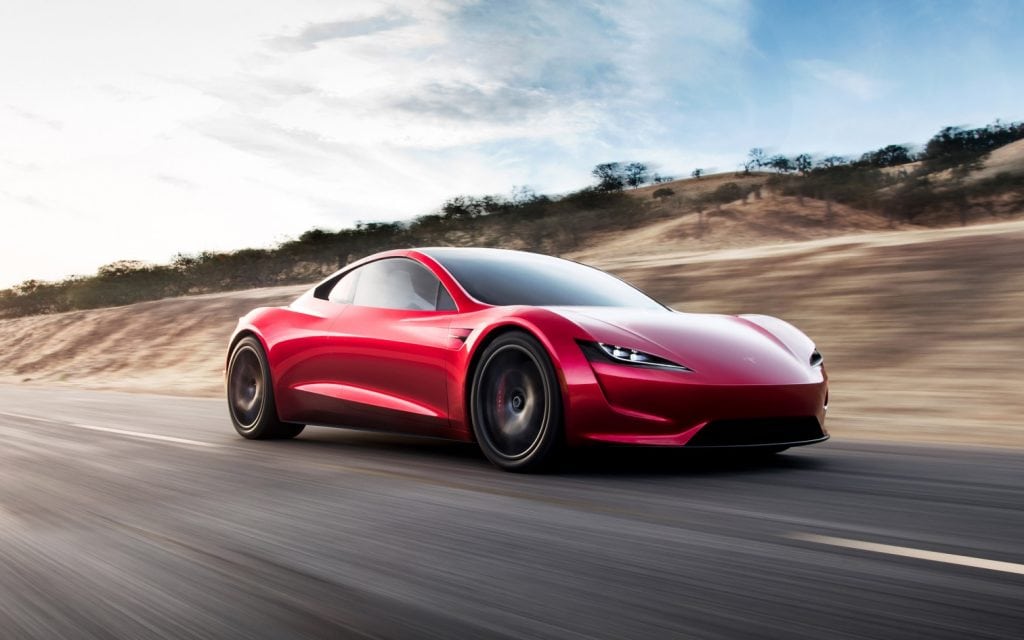
Semi
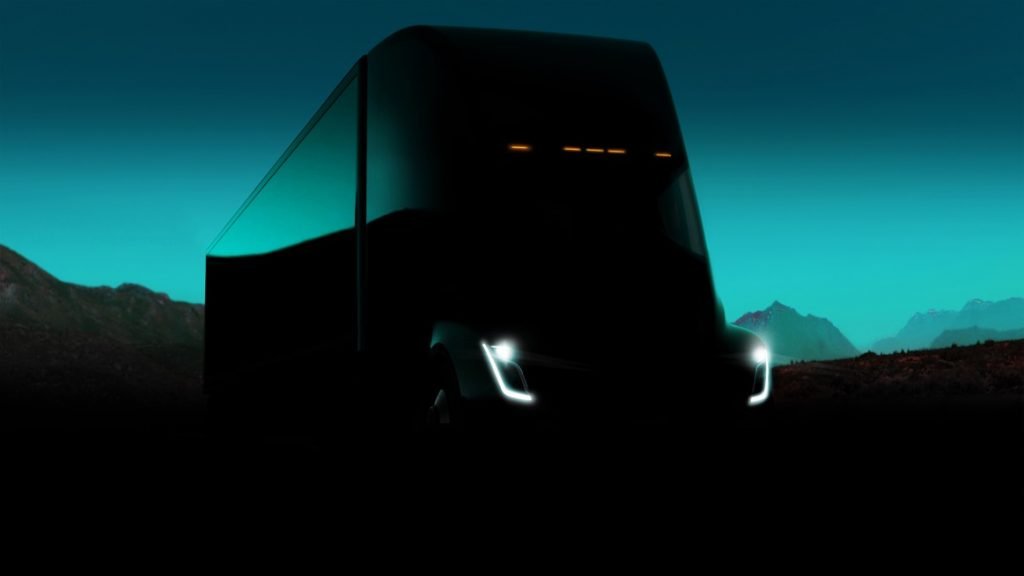
The Tesla Semi will deliver a far better experience for truck drivers, while increasing safety and significantly reducing the cost of cargo transport.
Unrivaled Performance
Without a trailer, the Tesla Semi achieves 0-60 mph in five seconds, compared to 15 seconds in a comparable diesel truck. It does 0-60 mph in 20 seconds with a full 80,000-pound load, a task that takes a diesel truck about a minute. Most notably for truck drivers and other travelers on the road, it climbs 5% grades at a steady 65 mph, whereas a diesel truck maxes out at 45 mph on a 5% grade. The Tesla Semi requires no shifting or clutching for smooth acceleration and deceleration, and its regenerative braking recovers 98% of kinetic energy to the battery, giving it a basically infinite brake life. Overall, the Semi is more responsive, covers more miles than a diesel truck in the same amount of time, and more safely integrates with passenger car traffic.
Driver Experience
Unlike other trucks, the Semi’s cabin is designed specifically around the driver, featuring unobstructed stairs for easier entry and exit, full standing room inside, and a centered driver position for optimal visibility. Two touchscreen displays positioned symmetrically on both sides of the driver provide easy access to navigation, blind spot monitoring and electronic data logging. Built-in connectivity integrates directly with a fleet’s management system to support routing and scheduling, and remote monitoring. Diesel trucks today currently require several third party devices for similar functionality.
Megachargers, a new high-speed DC charging solution, will add about 400 miles in 30 minutes and can be installed at origin or destination points and along heavily trafficked routes, enabling recharging during loading, unloading, and driver breaks.
Safety
The Tesla Semi’s all-electric architecture is designed to have a higher safety standard than any other heavy-duty truck on the market, with a reinforced battery that shields the Semi from impact and gives it an exceptionally low center of gravity. Its windshield is made of impact resistant glass. Jackknifing is prevented due to the Semi’s onboard sensors that detect instability and react with positive or negative torque to each wheel while independently actuating all brakes. The surround cameras aid object detection and minimize blind spots, automatically alerting the driver to safety hazards and obstacles. With Enhanced Autopilot, the Tesla Semi features Automatic Emergency Braking, Automatic Lane Keeping, Lane Departure Warning and event recording.
Tesla Semi can also travel in a convoy, where one or several Semi trucks will be able to autonomously follow a lead Semi.
Reliability
With far fewer moving parts than a diesel truck – no engine, transmission, after-treatment system or differentials to upkeep – the Tesla Semi requires significantly less maintenance. Its battery is similar in composition to the batteries of Tesla energy products and is designed to support repeated charging cycles for over a million miles, while its motors are derived from the motors used in Model 3 and have been validated to last more than one million miles under the most demanding conditions.
Lowest Cost of Ownership
All-in, the Tesla Semi delivers massive savings in energy costs, performance, efficiency and reliability.
The biggest immediate cost-advantage comes from savings in energy costs: fully loaded, the Tesla Semi consumes less than two kilowatt-hours of energy per mile and is capable of 500 miles of range at GVW and highway speed, accommodating a wide range of shipping applications given that nearly 80% of freight in the U.S. is moved less than 250 miles. Coupled with the low and stable nature of electricity prices – which average $0.12/kWh in the U.S. and can be significantly less for commercial and industrial users, falling to almost nothing when combined with local solar generation and storage – owners can expect to gain $200,000 or more in savings over a million miles based on fuel costs alone.
Reservations for the Tesla Semi can be made for $20,000 USD per truck. Production in 2019.
Model 3
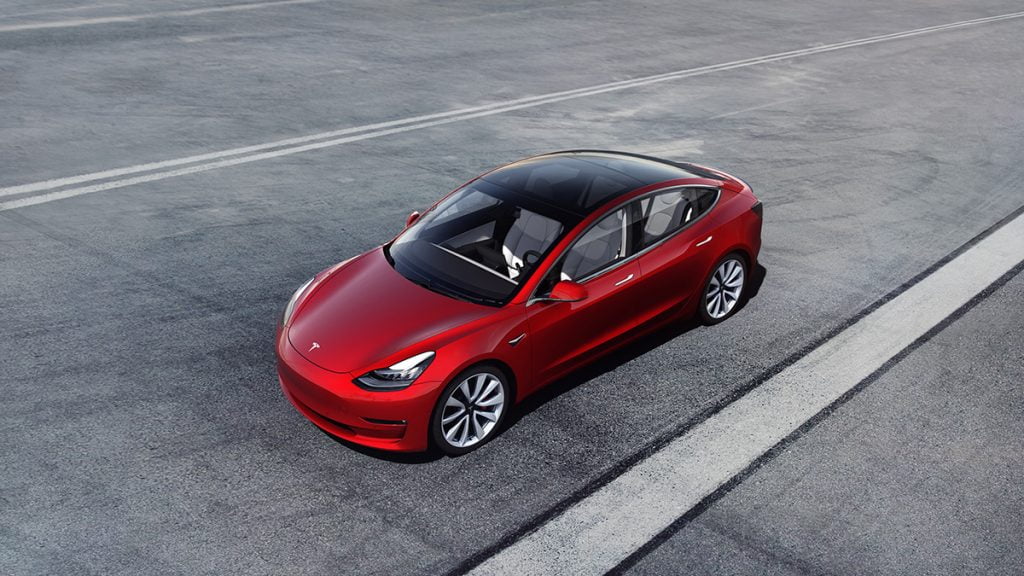
Model 3 is a smaller, simpler and a more affordable electric car. Designed and built as the world’s first mass-market electric vehicle, it is a critical step in Tesla’s mission to accelerate the world’s transition to sustainable energy.
Like every Tesla vehicle, Model 3 combines range, performance, safety and technology. Intelligent design maximizes interior space to comfortably fit five adults and all of their gear. The high-efficiency powertrain provides zero to 60 mph acceleration in as little as 3.2 seconds.
Model 3 is designed to achieve the highest safety ratings in every category. With 220 to 325 miles of range and a starting price of $35,000 before gas savings and incentives, Model 3 is Tesla’s most affordable vehicle yet.
Model 3 deliveries began on July 28, 2017 at the Tesla Factory in Fremont, CA. It is currently available for purchase on Tesla.com in a number of different configurations, including Standard Range, Mid Range, and Long Range battery options. Certain variants are available with Dual-Motor All-Wheel Drive for superior performance and traction in any weather, and Model 3 Performance is also available for best-in-class acceleration. Please visit our Design Studio to see available options.
VEHICLE SPECIFICATIONS
Dimensions & Weight
- Length: 184.8”
- Width: 82.2” (76.1” with mirrors folded)
- Height: 56.8”
- Wheelbase: 113.2”
- Track (wheel center): 62.2” front and rear
- Ground clearance: 5.5”
- Head room, standard: 39.6” front row, 37.7” second row
- Head room, glass roof: 40.3” front row, 37.7” second row
- Leg room: 42.7” front row, 35.2” second row
- Shoulder room: 56.3” front row, 54.0” second row
- Hip room: 53.4” front row, 52.4” second row
- Seating capacity: 5 adults
- Luggage capacity: 15 cubic feet
- Weight distribution:
- 47% front, 53% rear (Model 3)
- 48% front, 52% rear (Model 3 Mid Range and Long Range RWD)
- 50% front, 50% rear (Model 3 Dual Motor and Performance)
Body
- Hybrid steel/aluminum body
- Drag coefficient of 0.23
Chassis
- Double wishbone, virtual steer axis front suspension with coil over twin-tube shock absorbers and stabilizer bar
- Independent multi-link rear suspension with twin-tube shock absorbers and stabilizer bar
- Variable ratio, speed sensitive electronic power steering
- Electromechanically boosted four wheel anti-lock disc brakes with electronic brake force distribution
- 18” aero or 19” sport or 20” performance wheels with various tire options
Standard Accessories
- 20 foot mobile connector with storage bag
- 240 volt NEMA 14-50 adapter
- 120 volt NEMA 5-15 adapter
- J1772 public charging adapter
Charging Rates
Standard Battery
- Supercharging rate: 150 miles of range per 30 minutes
- Home charging rate: 37 miles of range per hour (240V outlet, 40A)
Mid Range Battery
- Supercharging rate: 150 miles of range per 30 minutes
- Home charging rate: 37 miles of range per hour (240V outlet, 40A)
Long Range Battery
- Supercharging rate: 170 miles of range per 30 minutes
- Home charging rate: Home charging rate: 37 miles of range per hour (240V outlet, 40A)
Model S
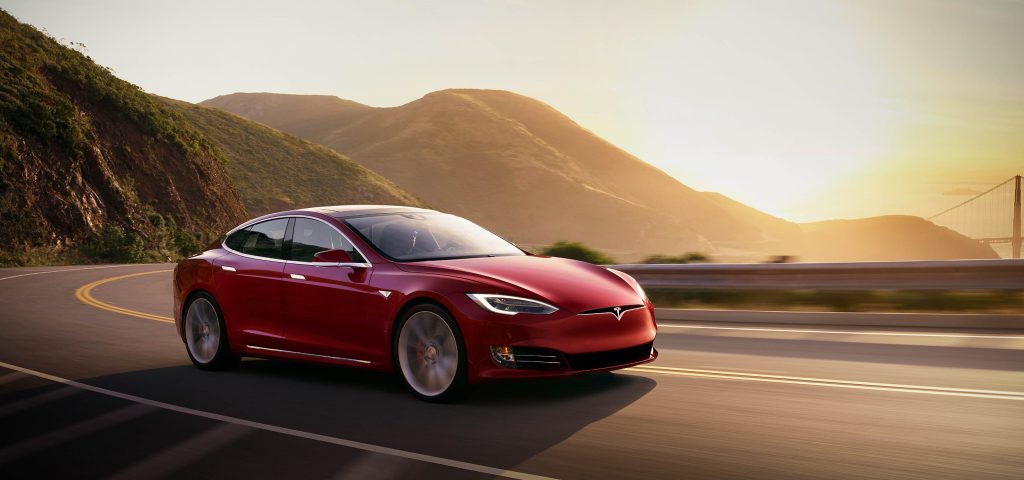
Model S, the first fully electric sedan, is an evolution in automotive engineering. Combining performance, safety, and efficiency, it has reset the world’s expectations for the car of the 21st century with the highest possible safety ratings, the longest range of any electric vehicle, and over-the-air software updates that continuously make it better.
Tesla Architecture
Built on the Tesla platform, the battery’s location on the floor gives Model S an extremely low center of gravity, greatly reducing the risk of rollover while at the same time enhancing handling and performance. Without an engine, Model S has a crumple zone much larger than other performance sedans to absorb the energy of a front end impact.
Safety
Model S is one of the safest cars on the road. Much of its safety is owed to the unique electric drivetrain that sits beneath the car. Model S has a low center of gravity, minimizing rollover risk. Model S’s safety record is proven by its NHTSA and Euro NCAP 5-star safety rating along with setting a record of the lowest likelihood of injury to occupants when tested in the United States.
Electric All Wheel Drive
With two motors, one in the front and one in the rear, Model S digitally and independently controls torque to the front and rear wheels. The result is unparalleled traction control in all conditions. Unlike conventional all-wheel drive vehicles that sacrifice fuel efficiency for increased traction, Tesla’s Electric All Wheel Drive system increases efficiency.
Performance
Reaching 0-60 mph in a mere 2.5 seconds, Model S is the quickest four-door sedan ever built.
Superior handling is the result of an extremely low center of gravity, thanks to the battery pack along the floor pan, centered between the axles. No other production car has a more ideal placement of mass for optimal handling.
Storage
Without an internal combustion engine, Model S allows for additional cargo space and offers a spacious cabin fitting five adults.
Touch Screen
The 17” center touchscreen seamlessly integrates media, navigation, communications, cabin control and vehicle data into one intuitive interface. Many functions are mirrored on the instrument panel and are voice-activated to focus the driver’s attention on the road.
Efficiency
Model S allows you to travel anywhere without using a drop of gasoline. The EPA rates the efficiency of Model S as equivalent to 90 mpg.
Over-The-Air Software Updates
Over-the-air software updates add functionality, enhance performance, and improve the driving experience of Tesla vehicles. Similarly to how you receive updates to your smartphone, Model S owners receive updates to their car remotely without visiting a service center. The ability to receive these updates is free for the life of the vehicle.
Model S Specs
Charging
- Access to Tesla’s expanding Supercharger network
- Mobile connector with 110 volt, 240 volt, and J1772 adapters
Interior
- 17″ capacitive touchscreen
- Maps and navigation with real-time traffic-based routing
- Automatic keyless entry
- Wi-Fi and cellular internet capability
- Mobile app remote control
- Retracting door handles
- Heated seats throughout the cabin
- Heated steering wheel
- One touch power windows
- High definition backup camera
- GPS enabled Homelink
- Hands free talking with Bluetooth
- Voice activated controls
- FM radio and Bluetooth® connectivity, with on-demand & internet radio capability
- Custom audio system featuring 11 speakers
- Auto dimming mirrors
- Power folding, heated side mirrors with memory
- Two USB ports for media and power
- 12 volt power outlet
- Twelve way power adjustable, heated front seats with memory and driver profile
- Subzero weather package with heated rear seats and wiper blade and windshield washer fluid defrosters
- Front trunk (no engine!), rear trunk, and 60/40 folding rear seats with 63.3 cubic feet of storage
Safety
- Active safety technologies, including collision avoidance and automatic emergency braking
- HEPA air filtration system
- Daytime running lights
- Smart Air Suspension for raising and lowering ride height
- Eight airbags for driver and passenger heads, knees, and pelvis plus two side curtain airbags
- Electronic stability and traction control
- Fog and cornering lights
- Four wheel antilock disc brakes with electronic parking brake
- Three second row LATCH attachments for child seat installations (accommodates three child seats simultaneously: two with LATCH and one with top tether and belt)
Convenience
- Power liftgate
- Lighted door handles
- Interior accent lighting
- Wiper blade defrosters
- Washer nozzle heaters
Model X
Model X is the safest, quickest and most capable sport utility vehicle in history. It blends performance and utility with unique features including the falcon wing doors, canopy glass and seven-seat configuration.
Tesla Architecture
Built on the Tesla platform, the battery’s location on the floor gives Model X an extremely low center of gravity, reducing the risk of rollover common in SUVs. Without an engine, Model X has a crumple zone much larger than other SUVs to absorb the energy of a front end impact. Along with standard active safety features, Model X received a 5-star safety rating in every category and sub-category by the National Highway Traffic Safety Administration (NHTSA), making it the first SUV ever to earn the 5-star rating across the board.
Falcon Wing Doors
Model X Falcon Wing doors offer unprecedented convenience, entry, and maneuverability. With less space needed to open than the sliding door of a minivan, the double hinged doors make loading a child in the backseat in tight parking spaces simple. Why should the driver ever need to touch the door? Auto presenting doors automatically open and close as the driver approaches or exits Model X.
Panoramic View
With a windshield that stretches up and over the two front seats, passengers can experience an open and modern feel with an expansive view ahead.
Fit everything
Three rows of seats, a front and rear trunk, room under the second row seats, side pockets and a blind holster for your iPhone, big or little, there’s a place to store it in Model X.
For even heavier cargo, Model X is the first electric vehicle with a 5,000 lb. towing capacity.
Breathe Easy
Model X is the world’s cleanest SUV on the inside. With a HEPA filter system, medical-grade air can fill the cabin, no matter what is going on outside.
There are three modes: circulate with outside air, re-circulate inside air and a bioweapon defense mode that creates positive pressure inside the cabin to protect occupants.
Agility, Speed and Aerodynamics
Model X hits 0-60 mph in a staggering 2.9 seconds getting to a top speed of 155 mph, all while producing zero emissions. With an active spoiler that automatically adjusts for maximum efficiency, Model X has the lowest drag coefficient of any SUV.
Model X Specs
Technology
- Regular over-the-air updates add new features and enhance existing functionality via Wi-Fi
- Access to Tesla’s expanding Supercharger network
- Maps and navigation with real-time traffic-based routing
- GPS enabled Homelink
- Custom audio system featuring 17 speakers
Safety
- Active safety technologies, including collision avoidance and automatic emergency braking
- HEPA air filtration system
- Electric All-Wheel Drive for maximum efficiency and traction
- Parking sensors and blind spot warning
- Full LED headlamps
- Power-folding, heated side mirrors
- Up to four LATCH child seat attachments
Convenience
- Largest glass panoramic windshield in production, providing unparalleled views
- Falcon Wing doors allow easy access to second and third row seats, even from tight parking spaces
- Automatic keyless entry
- Heated seats throughout the cabin
- Heated steering wheel
- Wiper blade defrosters
- Washer nozzle heaters
- Self-presenting front door
- Power liftgate
- Largest interior storage capacity of its class: 77 cubic feet in the six seat interior configuration
- Front trunk with room for luggage, strollers or two golf bags
Warranty
- 8 year, infinite mile battery and drive unit warranty
- 4 year, 50,000 mile limited warranty
Safety
Tesla vehicles are engineered to be the safest cars in the world and have a unique combination of passive and active safety features to protect both Tesla drivers and passengers. Model S, Model X and Model 3 have all achieved a perfect 5-star safety ratings in every category and subcategory in U.S. government testing, and Model 3 was found to have the lowest probability of injury of any car the government has ever tested. Model S and Model X also previously achieved the second and third lowest probabilities of injuries when tested by the U.S. government, and Model X was the first SUV to ever achieve a perfect 5-star rating across the board.
A primary safety benefit of all Tesla cars, compared with gas-powered vehicles, comes from our all-electric vehicle architecture and powertrain design. Our battery packs are mounted beneath the floor of the vehicle, creating an exceptionally low center of gravity that dramatically reduces rollover risk. The pack is fortified to prevent intrusion into the cabin and, coupled with the car’s rigid passenger compartment, helps distribute crash forces away from occupants in the event of a crash. Every Tesla also has a superior front crumple zone that is optimized to absorb energy and crush more efficiently than most cars that have a gas engine in the front. And, because of their electric design, Tesla cars are approximately 10 times less likely to experience a fire than a gas car.
Additionally, Tesla drivers and passengers also benefit from the many advanced safety features that come standard on all Tesla vehicles. These features include Automatic Emergency Braking, Lane Departure Warning, Forward and Side Collision Warning, and blind spot warnings to help reduce the likelihood of an accident. Unlike other automakers, we regularly improve the safety and functionality of our cars through over-the-air software updates to help ensure that Tesla owners have the latest safety technology regardless of when they purchased their car. In fact, we’ve also introduced entirely new safety features, such as Obstacle Aware Acceleration and Speed Limit Mode, to customers for free through over-the-air software updates.
Because the design of every vehicle on the road today is different, we provide first responders with detailed materials on how to act swiftly and effectively when encountering a Tesla that has been involved in a crash. Additionally, we regularly meet with first responders to share our training materials, and participate in on-site trainings to support their efforts.
Autopilot

At Tesla, we believe that technology can help improve safety. That’s why Tesla vehicles are engineered to be the safest cars in the world. We believe that the unique combination of passive safety, active safety, and automated driving is crucial for keeping not just Tesla drivers and passengers safe, but all drivers on the road.
Autopilot is an advanced driver assistance system that is classified as a Level 2 automated system according to SAE J3016, which is endorsed by the National Highway Traffic Safety Administration. This means Autopilot helps a driver with driver supervision. One of our main motivations for Autopilot is to help increase road safety, and it’s this philosophy that drives our development, validation, and rollout decisions.
Autopilot is intended for use only with a fully attentive driver who has their hands on the wheel and is prepared to take over at any time. While Autopilot is designed to become more capable over time, in its current form, it is not a self-driving system, it does not turn a Tesla into an autonomous vehicle, and it does not allow the driver to abdicate responsibility. When used properly, Autopilot reduces a driver’s overall workload, and the redundancy of eight external cameras, radar and 12 ultrasonic sensors provides an additional layer of safety that two eyes alone would not have.
Features
Autopilot includes a suite of features that drivers can use at their discretion to make driving safer and less stressful. These include:
- Traffic Aware Cruise Control – Traffic-Aware Cruise Control maintains the car’s speed in relation to surrounding traffic.
- Autosteer – Autosteer assists the driver by steering within a clearly marked lane.
- Auto Lane Change – Auto Lane Change assists drivers in transitioning to an adjacent lane on the right or left side of the car when Autosteer is engaged.
- Navigate on Autopilot – Navigate on Autopilot is an active guidance feature that, with driver supervision, guides a car from a highway’s on-ramp to off-ramp, including suggesting and making lane changes, navigating highway interchanges, and taking exits. It’s designed to make finding and following the most efficient path to your destination even easier on the highway when Autopilot is in use.
- Autopark – Autopark helps drivers automatically parallel park or perpendicular park their vehicle.
- Summon – With Summon, drivers can move their Tesla in and out of a parking space from outside the vehicle using the mobile app or the key.
Advanced safety features like Automatic Emergency Braking, Lane Departure Warning, Forward and Side Collision Warning, Obstacle Aware Acceleration, blind spot warnings and other important safety features that come standard on all Teslas. These features are made possible by our Autopilot hardware and software system and are standard in all vehicles, even for customers who have not purchased Autopilot.
How it Works
Drivers engage Traffic Aware Cruise Control and Autopilot in Model S and Model X by using the cruise control stalk on the left of the steering column; in Model 3, drivers use the gear selector stalk on the right of the steering column for those functions. A single pull on the stalk engages Traffic-Aware Cruise Control, and two successive pulls engages Autosteer. A grey steering wheel icon appears on the car’s display, next to the speedometer, when the system is available to engage. The icon appears highlighted in blue once the driver engages Autosteer. The system is intended for highway use.
Before enabling Autopilot, the driver first needs to agree to “keep your hands on the steering wheel at all times” and to always “maintain control and responsibility for your vehicle” (see alert.) Subsequently, every time the driver engages Autopilot, they are shown a visual reminder to “keep your hands on the wheel” (see alert.) Our advanced features like Autosteer and Summon are disabled by default. We do this to ensure that those using the feature do so knowingly and deliberately. To enable them, customers must go to the Autopilot Controls menu within the Settings tab and turn them on.
When Autosteer is in use, it measures the amount of torque that the driver applies to the steering wheel and, if insufficient torque is applied, an escalating series of audible and visual alerts again reminds the driver to place their hands on the wheel. Since the steering wheel rotates as it normally would when driving, the driver’s hands must move with the wheel. This helps ensure the driver is attentive, and that the steering wheel is properly oriented in the event the driver needs to take over. The system’s hands-on reminders and alerts are delivered based on each unique driving scenario, depending on numerous factors including speed, acceleration, road conditions, presence of other vehicles, obstacles detected, lane geometry, and other sensor inputs. If the driver repeatedly ignores those warnings, then the driver will be locked out from using Autopilot during that trip (see alert.) Additionally, if a driver tries to engage Autosteer when it is not available, the driver will be prevented from doing so. This is designed to prevent driver misuse, and is among the strongest driver-misuse safeguards of any kind on the road today.
If a driver wants to initiate an automated lane change, they must first enable Auto Lane Changes through the Autopilot Controls menu within the Settings tab. Then when the car is in Autosteer, a driver must engage the turn signal in the direction that they would like to move.
To use Navigate on Autopilot, a driver must first enable the feature in the Autopilot Controls menu within the Settings tab, and then enter a destination into the navigation system. Navigate on Autopilot must be enabled for each unique trip via the Navigate on Autopilot button on the map’s turn-by-turn driving directions. If Navigate on Autopilot is not available for a drive, the button will not appear on the turn-by-turn direction list. Once Navigate on Autopilot is in use, our 360-degree visualization on the center display shows a single blue line indicating the suggested path of travel. There are two types of lane changes that Navigate on Autopilot will suggest – route-based lane changes which are designed to keep you on your navigation route, and speed-based lane changes, which are designed to keep your vehicle moving as close to your set speed as possible. Navigate on Autopilot can be customized to a driver’s preferences and includes four settings for speed-based lane changes (Disabled, Mild, Average, or Mad Max). When enabled, Navigate on Autopilot’s speed-based lane changes will suggest transitions into adjacent lanes that are moving faster, in the event that your vehicle is traveling slower than the set cruise speed (for instance, if you approach a slow-moving car or truck ahead). The Mild setting suggests lane changes when you’re traveling significantly slower than your set speed, whereas Mad Max will suggest lane changes when traveling just below your set speed. A video that shows this process is below.
To use Autopark, a car must be driving at a very low speed on a street, and a “P” will appear on the Instrument Panel when a Tesla detects a parking spot. Then, a driver must put the car in reverse and press start, and Autopark will begin to maneuver the vehicle into the parking space by controlling the vehicle speed, gear changes and steering angle.
To use Summon, a driver must open the Tesla app, press Summon and then press the forward or reverse buttons. Model S and Model X owners can use Summon with their key fob by holding the center of the key fob for three seconds until the car’s hazard lights come on, and then pressing either the frunk or trunk button on key fob to Summon forwards and backwards respectively.
The driver can override any of Autopilot’s features at any time by steering, applying the brakes, or using the cruise control stalk to deactivate.
Hardware + Software
Autopilot’s robust sensor and camera suite provides drivers with an awareness of their surroundings that a driver alone would not otherwise have. Cars built between September 2014 and October 2016 include one camera and less-powerful radar and ultrasonic sensors. All Tesla vehicles built since October 2016 include eight external cameras that feed our Tesla-developed neural net, 12 ultrasonic sensors for detecting nearby obstacles, a forward-facing radar that senses through fog, dust, rain, snow, and under cars, and a powerful onboard computer that process these inputs in a matter of milliseconds. With the future introduction of our Tesla-developed AI chip, the speed at which our system processes data will increase by an order of magnitude. While this processing power is not needed for Autopilot, it is a meaningful leap toward our full self-driving future.
Because every Tesla is connected, Tesla cars are able to get better over time with software updates and the introduction of new features through over-the-air updates. This is even more true with Autopilot as we continuously work to make the system even more capable and keep our customers at the forefront of technology.
Charging
A critical component of the adoption of electric vehicles is to create a seamless and convenient charging experience wherever customers choose to travel. Tesla owners can enjoy the convenience of plugging in anywhere to charge. Whether it’s at home, in the office, or on a long distance road trip, Tesla has you covered.
Charge from home
The most convenient way to charge your Tesla is at home. Model S, Model X and Model 3 provide ample range for daily travel. The majority of owners drive during the day and replenish the balance of remaining charge at night, waking to a full battery in the morning. Imagine never going to a gas station again.
Supercharge on the road
Designed and built by Tesla, Supercharger stations charge Model S, Model X and Model 3 in minutes rather than hours. Superchargers are strategically placed to allow owners to drive from station to station with minimal stops. Stations are located near amenities like roadside diners, cafes, wi-fi hotspots, and shopping centers.
The Supercharger is substantially more powerful than any charging technology to date, providing up to 120 kilowatts of power to replenish a half charge in about 30 minutes.
The Supercharger network covers major routes in North America, Europe, and Asia Pacific. There are more than 10,000 Superchargers worldwide.
Recharge at your destination
The Destination Charging program replicates the convenience Model S, Model X and Model 3 owners are accustomed to at home by providing hotels, restaurants, and resorts with the same connectors our owners often install in their garages. Wall Connectors add up to 60 miles of range per hour, easily giving Model S, Model X and Model 3 a full charge in a few hours.
To see all of our current locations, visit our Find Us tool.
Energy Products
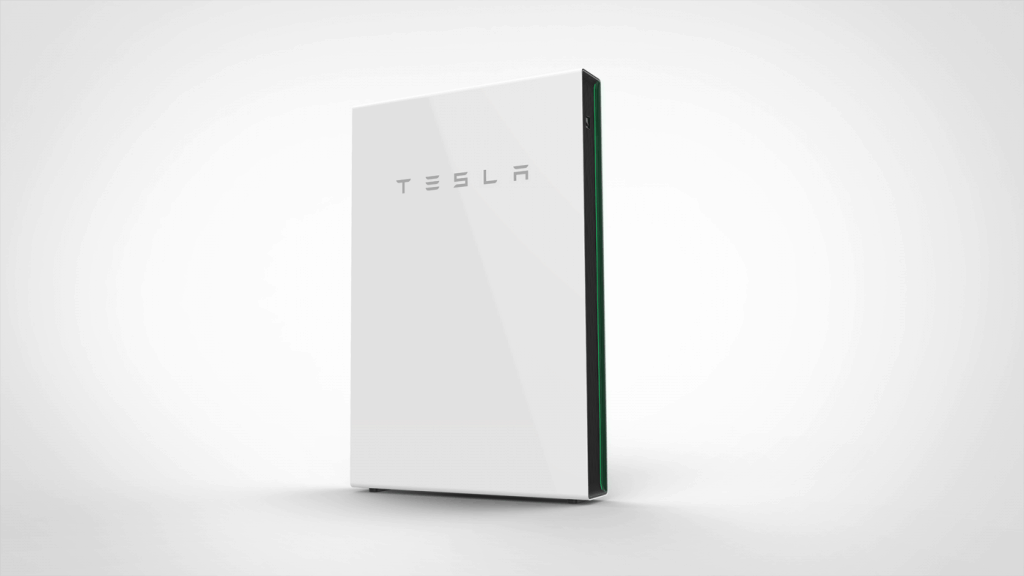
The world currently consumes 20 trillion kWh of energy annually.
In 2016, CO2 concentration levels permanently exceeded the alarming 400 parts per million threshold. Many climate scientists believe this level will have a catastrophic impact on the environment.
Tesla’s mission is to accelerate the world’s transition to sustainable energy – so that we can have a better future.
There are three key components that can help address climate change and have a positive impact on the world: sustainable energy generation, batteries and electric cars. These solutions already exist independently, but when combined, they become even more powerful.
Solar Roof
Solar Roof is a complete roof that is beautiful, durable and brings renewable electricity production to any home. The goal was to create a roof that would make homes look better while reducing the cost of electricity.
Solar Roof consists of uniquely designed and extremely durable glass tiles that complement the aesthetics of any home. It is customizable for a variety of different home styles, each uniquely engineered so that the photovoltaic cells are invisible. Customers can choose which sections of their roof will contain the hidden solar technology while still having the entire roof look the same. These new roofs seamlessly supply renewable energy to homes, battery storage systems and back into the grid, creating savings for owners. When paired with Powerwall, Tesla’s home battery, Solar Roof can power an entire home with 100% renewable energy.
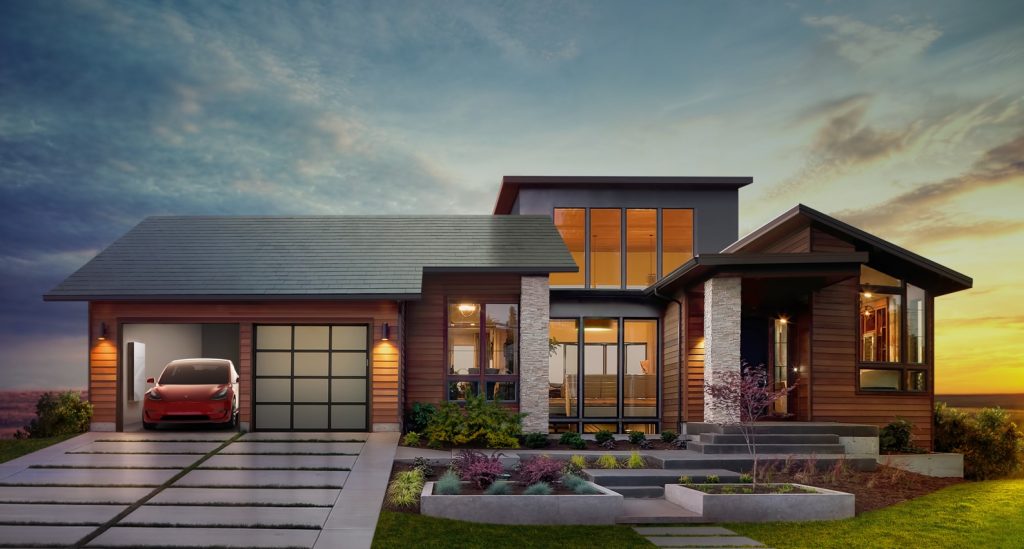
Solar Roof is offered in four beautiful styles – Textured Glass Tile, Slate Glass Tile, Tuscan Glass Tile, and Smooth Glass Tile – to complement a variety of architectural styles.
Powerwall
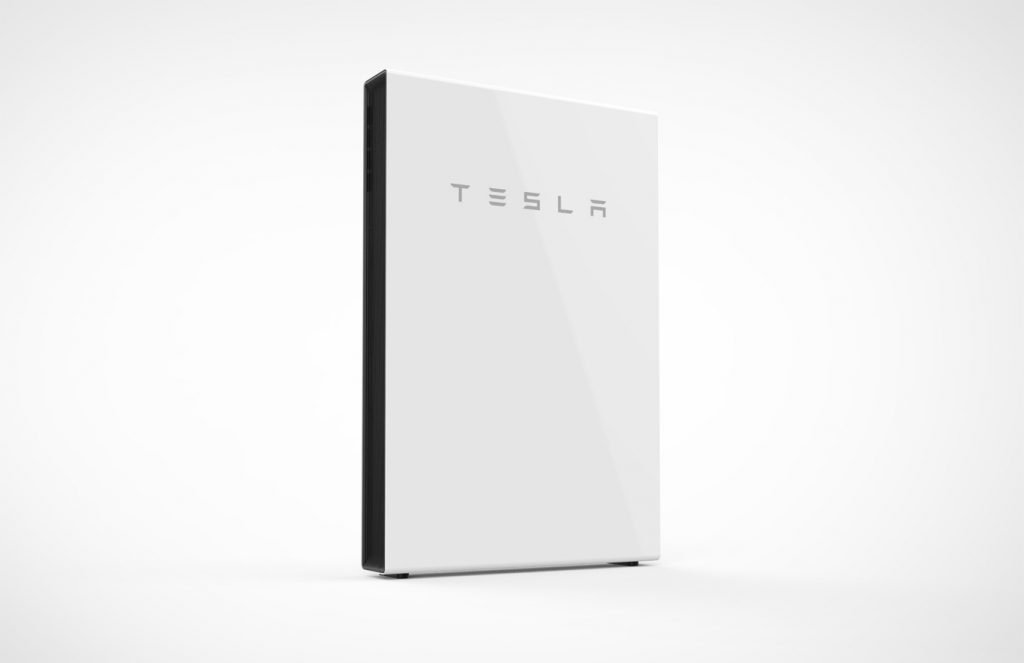
Introduced in October 2016, Powerwall is a rechargeable lithium-ion battery designed to enable self-consumption of solar power, emergency backup, time-based control and other grid service applications. The current design is the second generation of Powerwall, after the first version was launched in 2015.
Powerwall has 13.5 kWh of useable capacity and consists of a lithium-ion battery pack, liquid thermal control system, an integrated inverter and software that intelligently dispatches electricity when it’s needed most. The unit mounts seamlessly on a wall or on the ground, indoors or outdoors, and is integrated with the grid to export excess energy, maximizing the opportunity for economic benefit.
Powerwall can provide a number of different benefits to the customer including:
Self-Powered Home
Store excess solar energy not used at the time it is generated and use that energy later when the sun isn’t shining.
Backup Power
Assure backup power in the event of a utility power outage.
Time-Based Control
Set Powerwall to Time-Based Control to maximize savings. Advanced sensors learn patterns in energy usage and will use stored energy during peak hours when prices and demand are high.
Home Energy Monitoring
Track Powerwall and home energy consumption in real-time with the Tesla mobile app.
Powerwall specs:
- Mounting: Wall or Floor Mounted, Indoor/Outdoor
- Inverter: Fully integrated Tesla inverter
- Usable Capacity: 13.5 kWh
- Power: 5 kW continuous, 7 kW peak
- Round Trip Efficiency: 90%
- Operating Temperature Range: –20°C to 50°C (–4°F to 122°F)
- Warranty: 10 years
- Dimensions: 1150 mm x 755 mm x 155 mm (45.3 in x 29.7 in x 6.1 in)
- Weight: 125 kg (276 lbs)
Powerpack

Powerpack integrates batteries, power electronics, thermal management and controls into a turnkey solution that’s easy to install for businesses and utilities.
Powerpack began shipping to commercial and utility customers in September 2016. It features a new energy module and power electronics, providing twice the energy density of the previous Powerpack, and a more seamless integration into multiple levels of the grid. Powerpack is matched with a new inverter that’s designed by Tesla and manufactured at Gigafactory 1 in Sparks, Nevada. This inverter is the lowest cost, highest efficiency and highest power density utility-scale inverter on the market. It also significantly simplifies the installation process of the entire Powerpack system by integrating a number of previously independent components into the inverter itself.
Between one and 20 Powerpack systems can be connected per Tesla inverter, and larger systems can easily accommodate multiple inverters, enabling flexible system sizing and design for any project. Scalable from 200 kWh to 100+ MWh, Powerpack is the new standard for commercial and utility scale battery solutions.
For Businesses
Powerpack helps businesses gain greater control, efficiency and reliability across the electric grid by enabling them to:
- Avoid peak demand charges
- Buy electricity when it’s cheapest
- Participate in grid services
- Back up critical business operations in the event of a power outage
- Maximize consumption of on-site renewable power
Highlighted Customers
The StubHub Center
Home of Major League Soccer’s LA Galaxy, the StubHub Center powered up a 2 MWh system to help the stadium manage energy costs and reduce its impact on the Southern California power grid. Sports venues put a tremendous strain on the grid during short, powerful energy events. A Powerpack system enables StubHub to store electricity during off-peak times, when the grid is more capable and favors delivering excess electricity, then discharge to the stadium during peak evening hours when the grid is under its heaviest load. This project is the first deployment of battery storage technology at a major U.S. sports venue.
Singita Lebombo, Kruger National Park, South Africa
As the largest natural sanctuary in South Africa, the Kruger National Park has no access to utility power and had to rely solely on diesel generators. This iconic protected ecosystem has environmental sustainability at the core of its mission. A new microgrid was formed by pairing a 3.15 MWh Powerpack system to a solar power system from SolarAfrica. The lodge can now switch off diesel generators completely during the day and long into the night by storing excess solar energy in Powerpack. The microgrid provides long-term savings by reducing expensive diesel costs, an uncompromised guest experience, and continuous clean energy from the sun.
Cathedral College School – Rockhampton City in Queensland, Australia
Cathedral College School was in search of a solution that would bring clean, reliable and affordable electricity to its campus. An 85 kW solar system coupled with a 95 kWh Powerpack system is expected to generate enough energy to reduce the college’s grid electricity consumption by as much as 50%, as well as prevent a detrimental tariff shift. In addition, through peak shaving, a storage application that reduces the college’s utility demand charges, the college maximizes the value of the system and expects to realize a full system payback within six years.
For Utilities
For utility scale systems, 200 kWh battery blocks are grouped to scale from 500kWh to over 100MWh. These systems are capable of two-hour or four-hour continuous net discharge power using grid tied bi-directional inverters. Powerpack systems support applications including peak shaving, load shifting and demand response for commercial customers while offering renewable firming and a variety of grid services at utility scales. Powerpack enables utilities to:
- Firm up renewable generation by reconciling the intermittency of power from wind, solar, or hydro sources and storing excess capacity to dispatch when it’s needed.
- Increase resource capacity. Powerpack acts as on-demand capacity (either generation or T&D), while adding resiliency to the grid.
- Ramp Control – Powerpack can act as a buffer while the power output from a large generation source is ramping up or down, delivering power instantly to smoothly transition output to the required levels.
- Provide ancillary services such as frequency response.
- Defer costly and time-consuming grid infrastructure upgrades. Powerpacks consume no water and don’t require detailed environmental reviews.
- Manage peak demand by deploying power within seconds or milliseconds.
Highlighted Powerpack Utility Customers:
Southern California Edison – Ontario, California
In October 2015, a rupture in the Aliso Canyon natural gas reservoir near Los Angeles caused a methane gas spill that displaced more than 8,000 Californians and released an unprecedented 1.6 million pounds of methane into the atmosphere. Los Angeles was in need of a clean energy solution that could ensure grid reliability and protect the city from the risk of rolling blackouts. Tesla provided an 80 MWh Powerpack system at the Southern California Edison Mira Loma substation to deliver electricity during peak hours, helping to maintain reliable grid operation and reduce the need for electricity generated by fossil fuels such as natural gas. Read more
Kaua’i Island Utility Cooperative – Kaua’i, Hawaii
The 13 MW photovoltaic array plus 52 MWh Powerpack system stores solar energy created during the day and feeds it to the grid during the evening hours to help reduce the amount of diesel power generation needed to meet the island’s electricity demand. This system helps KIUC meet its goal of using renewable resources to generate half of Kaua‘i’s electricity by the end of 2019.
Hornsdale Battery Project – near Jamestown, South Australia
In September 2016, a 50-year storm damaged critical infrastructure in the state of South Australia, causing a state-wide blackout and leaving 1.7 million residents without electricity. Further blackouts occurred in the heat of the Australian summer in early 2017. In response, the South Australian Government looked for a sustainable solution to ensure energy security, and Tesla was selected to provide a 129 MWh Powerpack system to be paired with global renewable energy provider Neoen’s Hornsdale Wind Farm near Jamestown, South Australia. The Powerpack will charge using renewable wind energy and dispatch energy during peak hours to prevent blackouts and increase grid reliability. Read more
Ta’u Island – Tau, American Samoa
Ta’u Island in American Samoa used diesel generators as their main source of power for years, leaving the residents vulnerable to blackouts when diesel supplies were low and using hundreds of gallons of fossil fuels. To address the needs of Ta’u’s 600 residents, Tesla built 1.4 MW of solar generation capacity and 6 MWh of battery storage to power the island. Now, residents along with the local hospital, schools, fire and police stations, and local businesses no longer need to worry about outages or rationing. Additionally, their microgrid almost completely replaces diesel generators with more affordable solar energy, and is designed to optimize system performance and maximize savings. The battery system allows the island to use stored solar energy at night so they can use renewable energy around the clock.
Powerpack specs:
2-hour System
· AC Energy: 174 kWh
· Round Trip Efficiency: 87%*
· Operating Temperature: -22ºF to 122ºF
· Scalable from: 50 kVa – 650 kVa
· Weight: 2073 kG / 4570 lbs
· Nominal Frequency: 50 or 60 Hz
· Powerpack Dimensions: L: 51.5” (1308 mm) W: 32.4” (822 mm) H: 86” (2185 mm)
4-hour System
· AC Energy: 210 kWh
· Round Trip Efficiency: 89%
· Operating Temperature: -30ºC to 50ºC
· Scalable from: 50 kVa – 650 kVa
· Weight: 2159 kg / 4750 lbs
· Nominal Frequency: 50 or 60 Hz
· Powerpack Dimensions: L: 51.5” (1308 mm) W: 32.4” (822 mm) H: 86” (2185 mm)
*Net energy delivered at 25°C (77°F) including thermal control.
Gigafactory
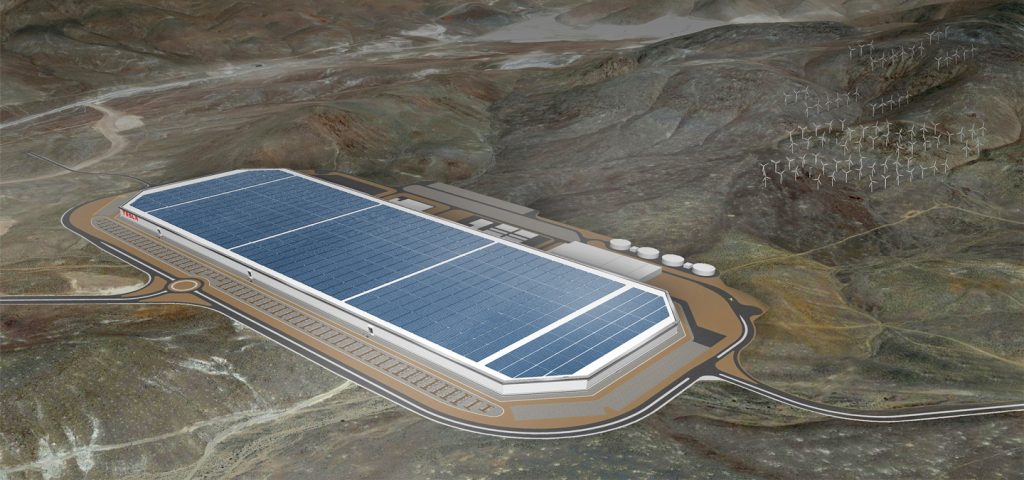
Tesla’s mission is to accelerate the world’s transition to sustainable energy through increasingly affordable electric vehicles and renewable energy generation and storage systems. At the heart of these products are batteries.
Tesla has seen enormous demand for energy products and electric vehicles. Today, there are more than 350,000 Tesla vehicles on the roads worldwide, and we’ve installed over 1 GWh of energy storage across the globe.
The Gigafactory was born out of necessity and will supply enough batteries to support Tesla’s projected demand. In mid-2018, battery production at Gigafactory 1 reached an annualized rate of roughly 20 GWh, making it the highest-volume battery plant in the world. Tesla currently produces more batteries in terms of kWh than all other carmakers combined. With the Gigafactory ramping up production, Tesla’s cost of battery cells will significantly decline through economies of scale, innovative manufacturing, reduction of waste, and the simple optimization of locating most manufacturing processes under one roof.
Gigafactory Facts & Figures
Land
- Total Land Area: 3,200 acres
- Biggest building in the world by footprint at 5.8 million square feet when compete
- The footprint of the completed Gigafactory will equate to about 101 football fields.
Construction
- Tesla broke ground on June 26, 2014.
- The current structure has a footprint of more than 1.9 million square feet, which houses more than 4.9 million square feet of operational space across several floors. This represents about 30% of the total finished Gigafactory.
- Once complete, we expect the Gigafactory to be the biggest building in the world.
- The factory is being built in phases so that we can begin manufacturing immediately inside the finished portions and, more importantly, adjust for improved learning as we build additional space.
Production
- The Gigafactory production line is extremely flexible and will allow for production changes inside the factory as battery technology and architecture change over the next decades.
- The Gigafactory manufactures battery cells, modules, and other components aimed to reduce costs, ensure a stable supply, and expand Tesla’s business accordingly.
- The Gigafactory currently produces Model 3 electric motors and battery packs, in addition to Tesla’s energy products, Powerwall and Powerpack.
Battery Cells
- The Gigafactory is producing a Tesla/Panasonic designed and engineered cell called a “2170 cell,” as the diameter is 21mm in x 70mm in height.
- The cell offers the best optimization of performance metrics needed for an EV at the lowest production cost. The size also works well for other large battery packs, such as Tesla’s energy products, Powerwall and Powerpack.
- Production of 2170 cells for qualification started in December 2016 and mass production began in January 2017. The cells coming off the line today are used in Model 3 and Tesla’s energy products, Powerwall and Powerpack.
Employment
- By bringing cell production to the U.S., Tesla will create thousands of more American jobs.
- Tesla continues to show an overwhelming commitment to the Nevada workforce, well beyond the state’s requirement that 50% of employees be Nevada residents. Nevadans currently average about 91% of the workforce at the Gigafactory.
- At peak production, the Gigafactory will employ 6,500 people and eventually as many as 10,000 employees. Indirectly, the Gigafactory will create between 20,000 to 30,000 additional jobs in the surrounding regions.
Energy use and recycling
- The Gigafactory is designed to be a net-zero energy factory upon completion. It will not consume any fossil fuels – there is no natural gas piped to the site nor are there permanent diesel generators being used to provide power. Emergency backup is fed from various electric sources, including renewable energy and storage products.
- The entire roof of the Gigafactory will be covered in solar array, and installation is already underway. Power not consumed during the day will be stored via Tesla Powerpacks for use when needed.
- To use water efficiently, the Gigafactory will have its own water recycling and treatment facility. The Gigafactory’s closed-loop water supply system uses numerous different treatment systems to efficiently recirculate water.
- Construction is underway for an on-site recycling facility that will safely reprocess all types of Tesla battery cells, modules, and packs for reuse in new cells or non-toxic solid waste by-product. They will eventually be returned to the Gigafactory at the end of their lifecycle, where components can be broken down and recycled to be used in new energy products.
